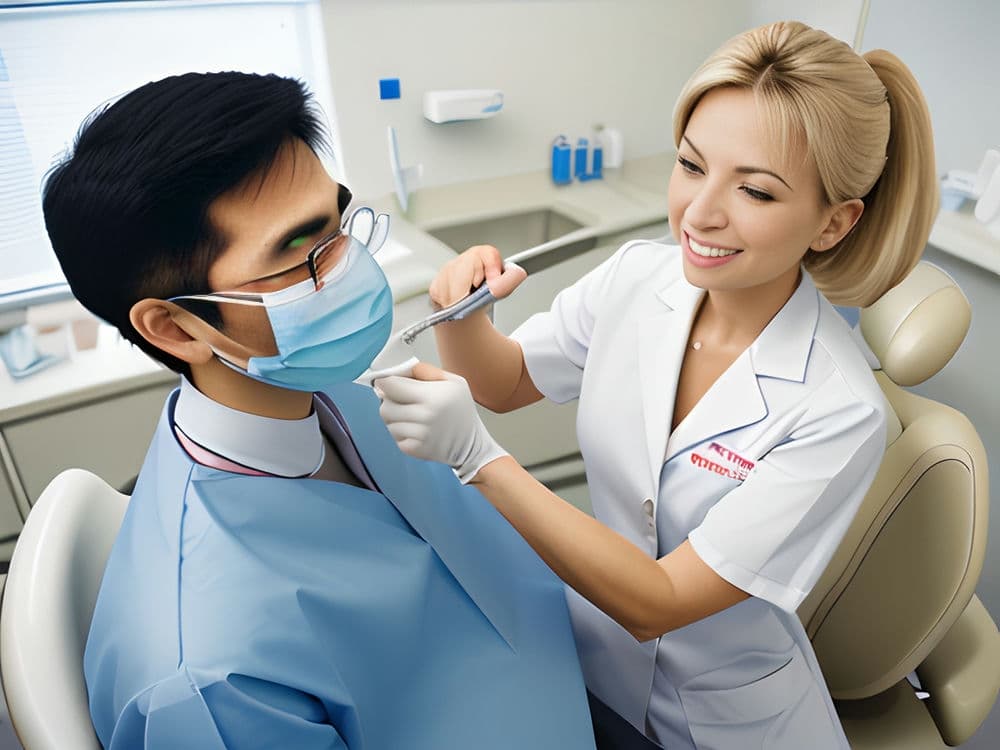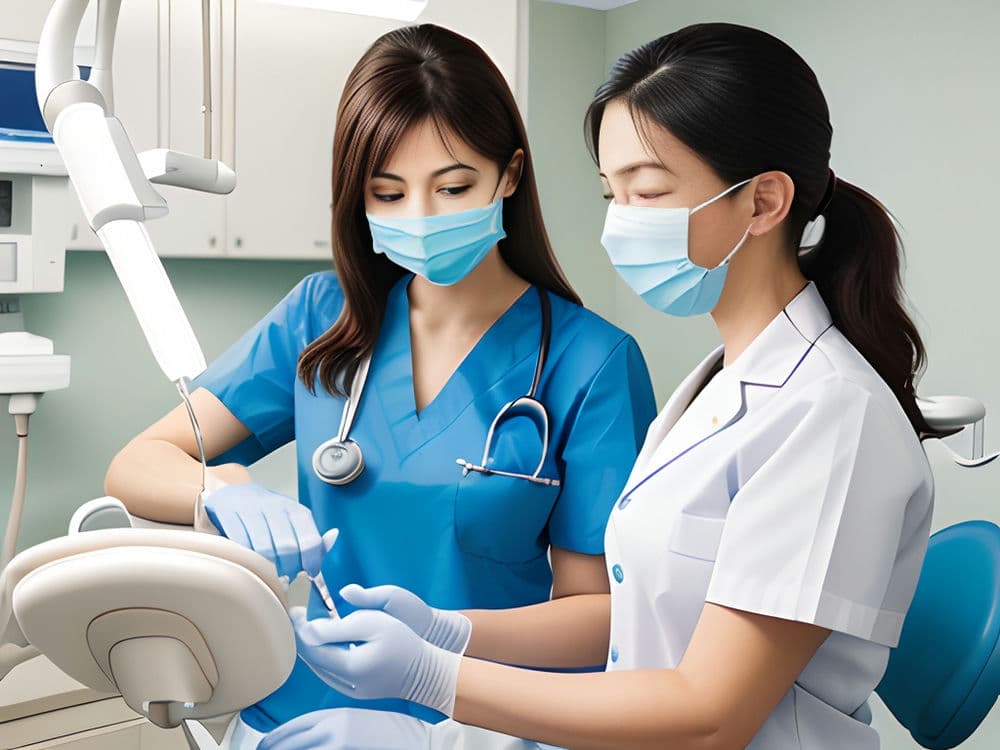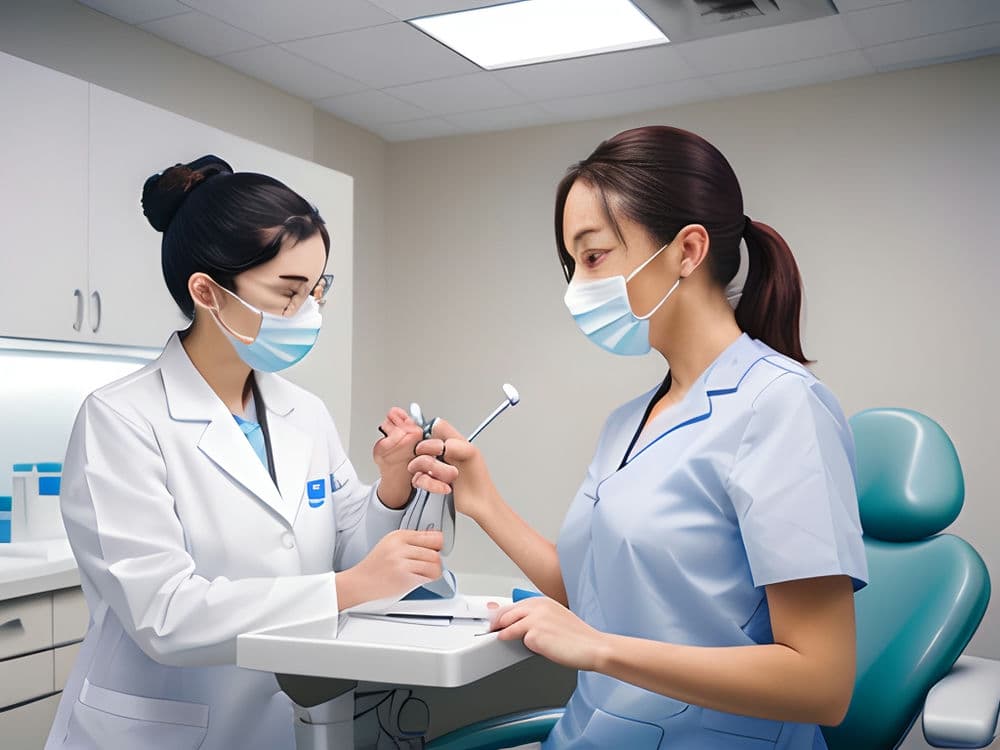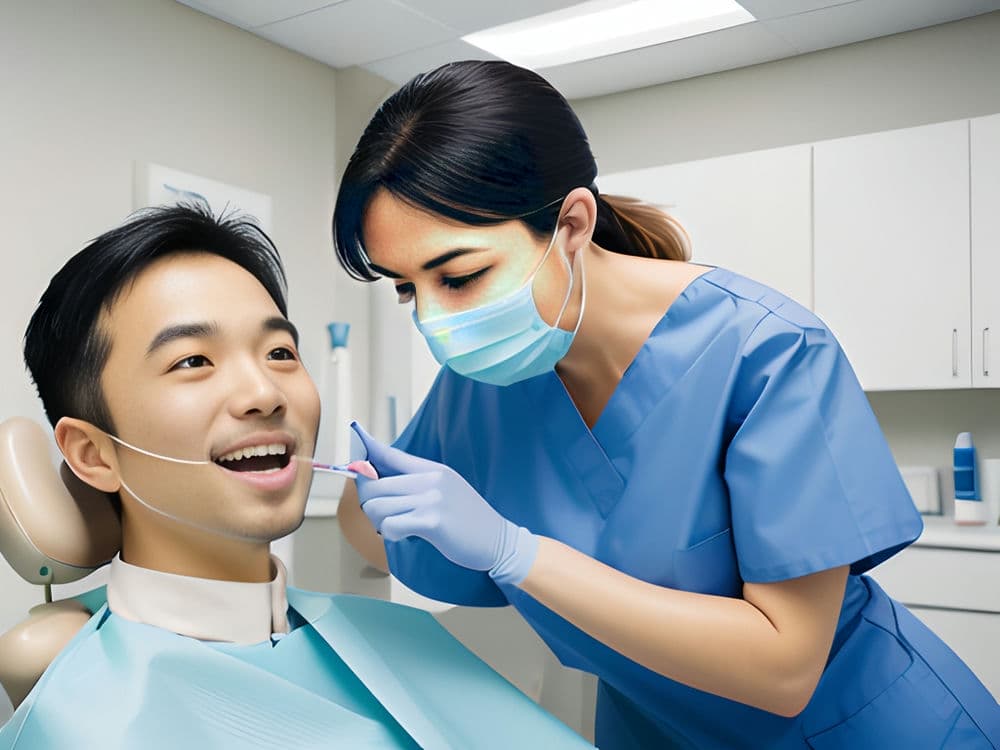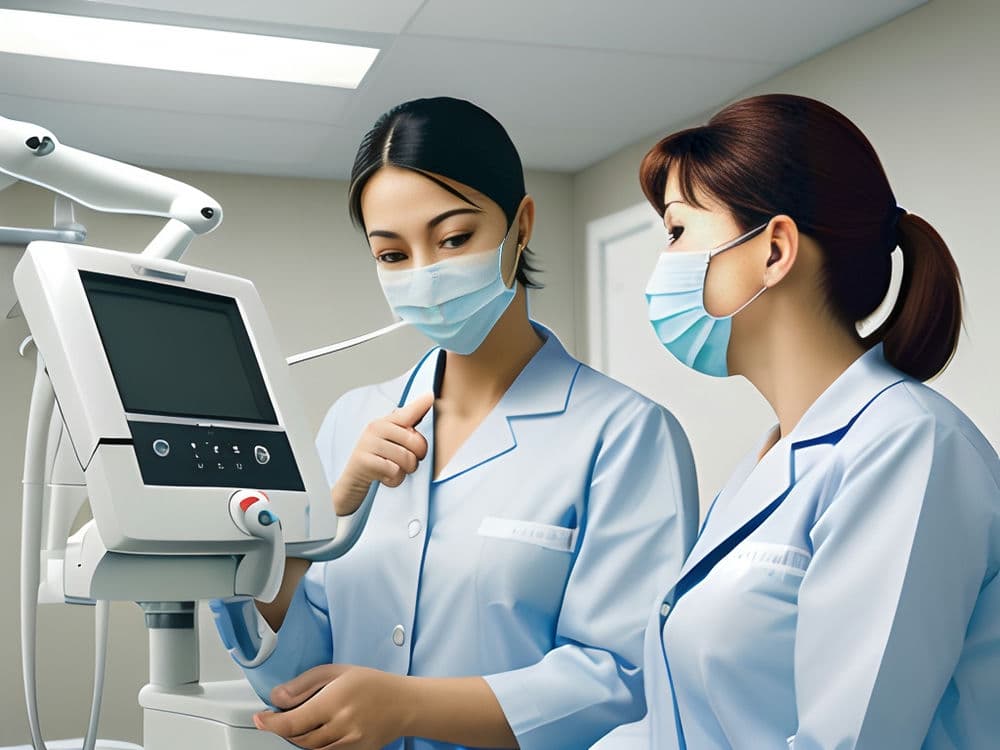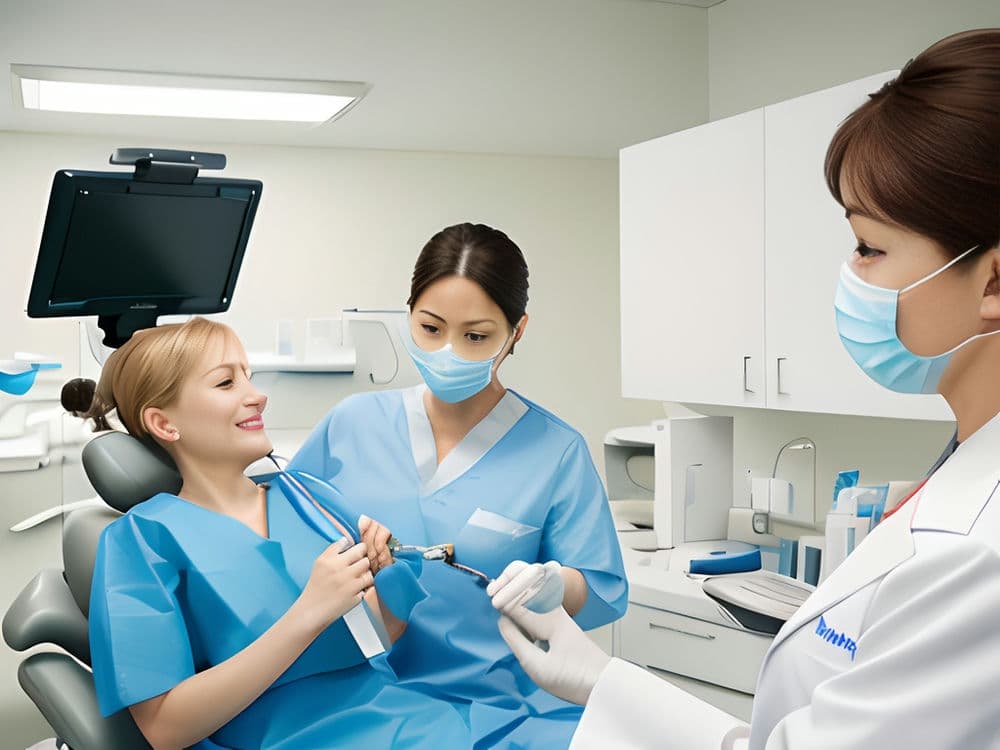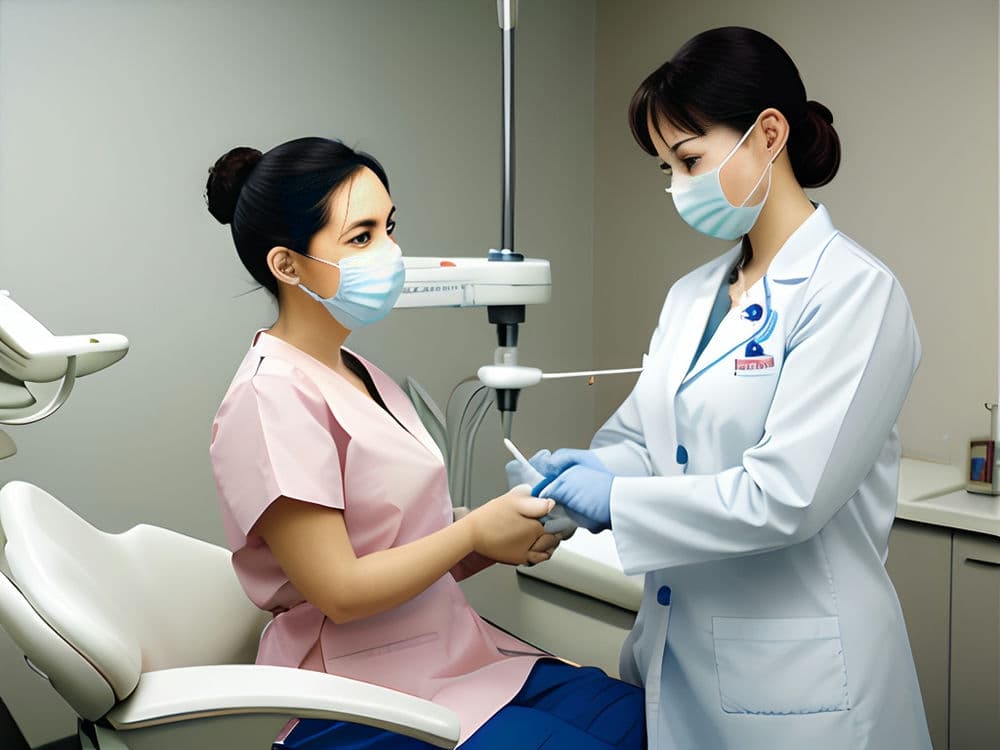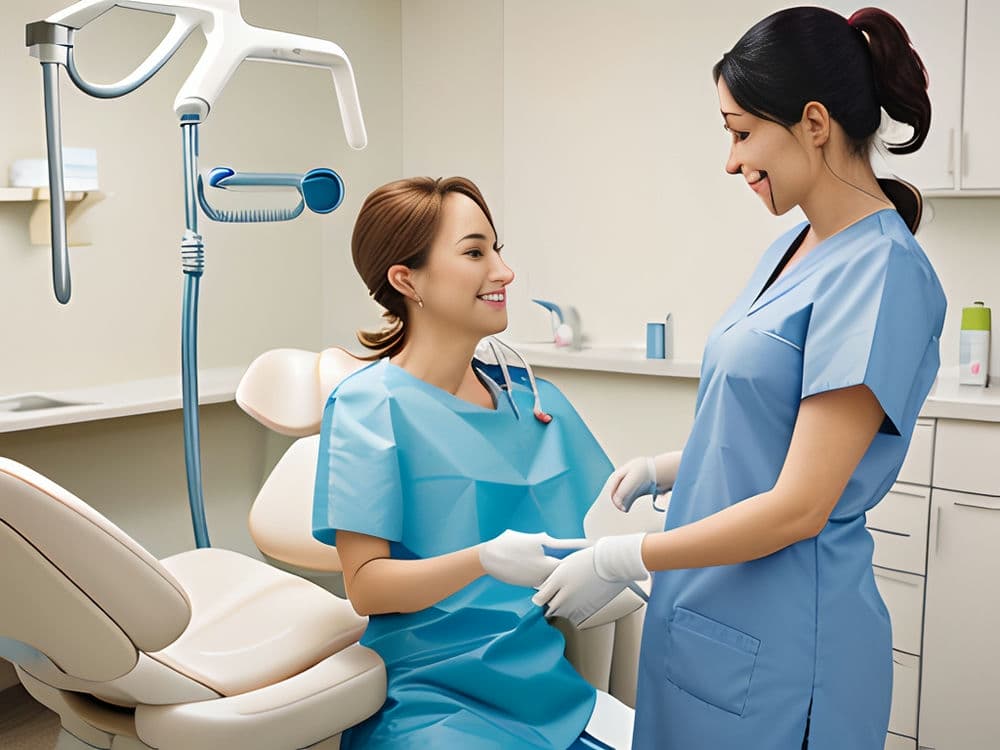In the dynamic field of orthodontics, a revolutionary shift is being observed as traditional impression techniques are being eclipsed by cutting-edge digital technologies. This paradigm change is not merely cosmetic; it heralds significant improvements in both patient experience and clinical outcomes.
Gone are the days of alginate and plaster, where patients endured the discomfort of biting into gooey substances that often triggered an unpleasant gag reflex. The physical molds, although effective for their time, were fraught with potential inaccuracies stemming from material instability or human error during the setting process.
Today's orthodontic landscape is increasingly dominated by digital impressions, which utilize advanced intraoral scanners to capture precise three-dimensional images of a patient's dentition. These digital systems offer unparalleled precision, drastically reducing the margin for error inherent in manual mold-making.
Moreover, this technological leap confers multiple benefits extending beyond mere accuracy. For one, it accelerates the entire treatment planning phase as these digital models can be instantly shared with labs or used to create orthodontic appliances without the delay associated with traditional shipping and handling of physical molds.
Patients also enjoy a more comfortable and engaging experience. They can avoid the messiness and discomfort of conventional impressions and instead witness their dental anatomy displayed on screens in real-time—a factor that enhances understanding and involvement in their own treatment plans.
Furthermore, these sophisticated imaging techniques have opened up new possibilities within orthodontics. Clear aligner therapies like Invisalign depend heavily on accurate dental mapping—something digital impressions provide with exceptional fidelity. Additionally, this approach facilitates remote monitoring and adjustments due to its seamless integration with teleorthodontics platforms—an aspect particularly valuable in today’s increasingly connected world.
Digital impressions represent just one facet of an ongoing evolution within orthodontic care aimed at improving efficiency, precision, and patient satisfaction. As such technologies become more widespread, they promise to continue enhancing not only how treatments are administered but also how swiftly patients can achieve their desired outcomes—a beautiful smile coupled with optimal oral health.
In the evolving world of orthodontic care, 3D imaging technologies have emerged as a cornerstone for enhanced diagnosis and treatment planning. This leap forward from traditional two-dimensional x-rays allows orthodontists to view the craniofacial structure in a fully realized three-dimensional context, revolutionizing their approach to patient care.
Unlike conventional imaging, 3D technologies such as Cone Beam Computed Tomography (CBCT) provide a comprehensive understanding of the patient's anatomical nuances. This clarity is pivotal for devising more accurate and individualized treatment strategies. With these detailed visualizations, practitioners can anticipate potential complications and adjust their methods accordingly.
The integration of 3D imaging into orthodontics also facilitates better communication with patients. Visualizing their dental structures in three dimensions helps patients understand the specifics of their condition and the proposed treatment plan. Informed patients are more likely to engage positively with their treatment journey, potentially leading to improved outcomes.
Furthermore, this advanced imaging technology plays a significant role in streamlining procedures such as dental implant placement, root canals, and assessments of tooth orientation and bone structure. It ensures that interventions are both minimally invasive and maximally effective—a dual benefit that enhances patient satisfaction.
As 3D imaging becomes increasingly accessible, it promises to further refine orthodontic diagnostics and treatments. The result is likely to be an era where personalized care is not just desired but delivered with unprecedented precision—ushering in improved functional and aesthetic outcomes for patients worldwide.
Accelerated orthodontic treatments represent a cutting-edge frontier within the dental discipline, promising to transform patient experiences and outcomes dramatically. Traditionally, individuals undergoing orthodontic care with braces or aligners could anticipate a journey lasting several years. However, innovative technologies and methodologies now seek to slash these timelines significantly.
Micro-osteoperforation (MOPs) exemplifies one such novel approach. By creating tiny perforations in jawbone tissue, MOPs stimulate a faster remodeling response, thereby moving teeth into their desired positions more rapidly than conventional techniques allow. Although this may sound uncomfortable, patients typically report minimal discomfort, thanks to local anesthesia administered during the short procedure.
Another noteworthy trend is low-level laser therapy (LLLT), which employs light energy to enhance cellular activity and accelerate tooth movement. LLLT's allure lies not only in its speed but also in its non-invasive nature—no incisions are necessary. As such, recovery periods diminish substantially, inviting a smoother transition towards ideal dental alignment.
Corticotomy-assisted orthodontics also accelerates treatment by making strategic bone cuts that temporarily soften the bone structure around teeth. This facilitates quicker adjustments while preserving overall bone integrity—a crucial consideration for long-term oral health.
While these accelerated methods promise swifter results, they don't compromise on quality or stability of outcomes. Orthodontists carefully plan each accelerated treatment to ensure that the final positioning of teeth is both aesthetically pleasing and functionally sound.
As research advances and more clinical trials validate these approaches, we can expect them to become increasingly commonplace in practices worldwide. Patients desiring swift transformations now have potent options at their disposal—options that cater not only to their desire for rapid change but also respect their need for safety and effectiveness.
In conclusion, accelerated orthodontic treatments are redefining expectations within dentistry by offering efficient pathways toward straighter smiles without sacrificing excellence in care or patient well-being—an exciting development for anyone eager to improve their dental aesthetics posthaste.
In the dynamic field of orthodontic care, the quest for reduced treatment duration is a persistent trend that resonates with both practitioners and patients. Traditional braces often require an extended period to achieve desired results, but recent advances promise swifter transformations without compromising quality outcomes.
One innovative approach involves vibration devices, designed to expedite tooth movement through gentle oscillations. These handheld tools emit micro-vibrations that encourage bone remodeling around the teeth, potentially hastening alignment adjustments. Though not universally endorsed due to varying empirical evidence, these devices have garnered interest as adjunctive treatments in orthodontics.
Another cutting-edge method is micro-osteoperforation (MOP), which directly influences bone biology to accelerate tooth movement. This minimally invasive procedure entails creating tiny perforations in the jawbone near the teeth being moved. MOP stimulates a healing response that increases cytokine activity, thereby facilitating quicker tooth migration within the alveolar bone.
Both vibration devices and MOP represent just two examples of how modern technology intersects with biological understanding to refine orthodontic therapy. As research continues and techniques evolve, it is likely that such methods will become more refined and their effectiveness better quantified.
These advancements stand at the vanguard of an orthodontic revolution where treatment times are diminished without sacrificing patient outcomes—ushering in an era where achieving a perfect smile can be realized on a notably shorter timeline.
In the ever-evolving field of orthodontics, patient experiences and their acceptance of accelerated treatment options are key indicators of progress. The latest trends in orthodontic care aim to improve patient outcomes by reducing the duration of treatment while maintaining high-quality results.
Traditionally, braces would be a long-term commitment, often lasting two or more years. However, with advancements such as micro-osteoperforations and vibration-based devices, this timeline is being significantly shortened. These innovative methods enhance the movement of teeth effectively, allowing for quicker transitions to desired positions.
Patients today seek not only efficiency but also comfort and aesthetic appeal. Clear aligners have addressed these desires head-on, offering a virtually invisible solution that can be customized to fit snugly over an individual's dentition. The convenience factor of these aligners – being removable for eating and cleaning – has resonated well with users.
Success in orthodontic treatments also relies on personalized care plans. Technological breakthroughs like 3D imaging allow for precise mapping of dental structures, leading to more accurate interventions tailored specifically for each patient's unique anatomy.
The introduction of teledentistry has further revolutionized patient care by providing remote monitoring capabilities. This facilitates frequent checks without necessitating physical visits to the clinic unless absolutely necessary. Such developments have been especially beneficial amidst global concerns about health and safety during times like the COVID-19 pandemic.
Moreover, patients are increasingly knowledgeable about their options thanks to online resources and forums where they can share experiences and advice. This democratization of information empowers patients to make informed decisions regarding their orthodontic care pathway.
Acceptance rates for accelerated orthodontic treatments reflect a growing trend towards embracing innovation for improved quality of life during—and after—the corrective process. As feedback continues to be overwhelmingly positive, it is clear that these cutting-edge approaches are reshaping both smiles and industry standards alike.
In conclusion, modern orthodontics is characterized by rapid advancements intended to optimize patient experiences and outcomes. From time-saving techniques to custom-tailored treatments facilitated by digital tools, there is an evident shift towards efficient yet effective care solutions that cater directly to patient needs and preferences—a trend likely only to continue as technology advances further into the future.
Minimally invasive techniques in orthodontics have revolutionized the way practitioners approach teeth alignment and bite correction. Traditionally, orthodontic treatment involved bulky metal braces that were often uncomfortable and aesthetically displeasing to patients. However, with advancements in dental technology, the industry has seen a shift towards more subtle, patient-friendly methods.
One of the latest trends is the use of clear aligners, such as Invisalign. These aligners are virtually invisible when worn and can be removed by the patient for eating and cleaning, offering a level of convenience previously unattainable with conventional braces. The aligners are custom-fitted to the individual's teeth using 3D computer-imaging technology, ensuring a precise treatment course.
Another minimally invasive technique is lingual braces. Unlike traditional braces that are placed on the front of teeth, lingual braces are attached to the backside. This placement makes them hidden from view while still providing strong corrective action similar to that of their traditional counterparts.
Orthodontic mini-implants, also known as Temporary Anchorage Devices (TADs), provide another example of less invasive procedures gaining popularity. TADs serve as fixed points from which to apply force to move teeth without affecting neighboring ones. They are small screws placed in strategic locations in the mouth and can significantly reduce treatment time.
Laser technology has also found its place in modern orthodontics for procedures such as gum contouring or speeding up tooth movement. Lasers can perform certain tasks with minimal discomfort and quicker healing times compared to traditional surgical methods.
Digital scanning has replaced the need for messy impressions used in creating models for dental appliances. Intraoral scanners create digital images of a patient's dentition quickly and accurately, enhancing patient comfort and improving diagnostic precision.
These minimally invasive techniques contribute positively to patient outcomes by reducing discomfort, shortening treatment duration, improving aesthetic concerns during treatment, and increasing overall satisfaction with orthodontic care. As these technologies continue to evolve and become more accessible, we can expect even greater emphasis on personalized treatments designed with both efficiency and comfort in mind for optimal patient experiences within orthodontics.
Orthodontic care has witnessed a significant evolution, with patient outcomes at the forefront of innovation. Traditionally, correcting dental irregularities often meant enduring cumbersome metal braces for extended periods. However, recent advances have paved the way for less invasive alternatives that promise improved aesthetics and comfort.
One such breakthrough is clear aligner technology. These transparent, removable devices have revolutionized orthodontics by providing a discreet option for patients self-conscious about wearing braces. Made of durable plastic, they gently guide teeth into their desired position without the need for brackets or wires.
Another trend is the use of mini-screws or temporary anchorage devices (TADs). These small screws are temporarily fixed to bone within the mouth to provide a stable anchor point from which teeth can be moved more precisely and efficiently. This method reduces treatment time and can improve outcomes for complex cases.
Lingual braces represent another advancement towards minimizing visibility of orthodontic appliances. Unlike traditional braces attached to the front of teeth, lingual braces are placed on their backside, hiding them from view while straightening teeth just as effectively.
Additionally, computer-aided design and 3D printing technologies have transformed treatment planning. Customized appliances can now be designed with precision to fit each patient's unique dental anatomy, leading to quicker and more predictable results.
Lastly, there's growing interest in photobiomodulation therapy – using light energy to accelerate tooth movement and reduce discomfort during adjustments. While still under study, early results suggest this technique could shorten treatment duration and enhance patient experience.
These advancements signify a new era in orthodontics where effectiveness converges with patient-centered care. Less invasive procedures not only yield positive clinical outcomes but also cater to individual lifestyle preferences – a trend likely to continue shaping the future of orthodontic treatments.
In the ever-evolving realm of orthodontic care, cutting-edge trends are significantly enhancing patient outcomes and comfort. A notable trend is the utilization of 3D imaging technology, which allows orthodontists to plan treatments with unprecedented precision. This minimizes the guesswork traditionally associated with braces adjustments and can lead to shorter treatment times.
Another innovation transforming patient experiences is the introduction of clear aligners as an alternative to traditional metal braces. These aligners are virtually invisible, offering aesthetic appeal particularly appreciated by adult patients. Moreover, they're removable, granting individuals the ability to maintain better oral hygiene during treatment and enjoy a broader range of foods without worry.
Furthermore, advances in materials science have led to more flexible and durable wires for braces that apply gentle pressure on teeth. This not only accelerates tooth movement but also reduces discomfort during adjustment periods. Consequently, patients experience less soreness and can resume their daily activities shortly after orthodontic appointments.
Customization has also taken center stage in modern orthodontics. Tailored appliances that fit perfectly into a patient's mouth contribute significantly to enhanced comfort levels. These personalized devices reduce irritation commonly caused by one-size-fits-all solutions and encourage adherence to treatment plans.
Finally, teledentistry has emerged as a convenient alternative for follow-up consultations. Patients can receive professional advice from the comfort of their homes without traveling to dental offices frequently—saving time and expediting post-treatment recovery.
In summary, these trends in orthodontic care signify monumental strides toward ensuring that patients not only achieve optimal dental health but do so with heightened comfort and efficiency—hallmarks of advanced medical practice in our contemporary world.
In the realm of orthodontic care, embracing interdisciplinary approaches has become a pivotal trend that is reshaping patient outcomes and elevating the standard of treatment. Orthodontics no longer operates in isolation; it now often involves collaborative strategies that integrate various healthcare disciplines to address complex dental issues holistically.
This integrative tendency is propelled by the understanding that teeth alignment influences and is influenced by numerous factors beyond mere dentistry. For instance, sleep apnea, a condition commonly associated with misaligned teeth or jaw structure, benefits from the combined insights of orthodontists, sleep specialists, and sometimes ENT doctors. By pooling their expertise, these professionals can devise comprehensive treatment plans that not only straighten teeth but also enhance overall respiratory wellness.
Another aspect where interdisciplinary care shines is in managing temporomandibular joint disorders (TMJDs). These painful conditions affecting the jaw joint and muscles require a multifaceted approach for effective management. Here, an orthodontist might work alongside physiotherapists and pain management experts to alleviate symptoms through physical therapy exercises, occlusal splints, or even cognitive-behavioral strategies to mitigate stress-related clenching or grinding.
Pediatric orthodontics also exemplifies this trend towards interprofessional collaboration. Growth modification treatments necessitate timing interventions perfectly with a child's developmental stages. Pediatricians' insights into growth patterns can therefore be invaluable for orthodontists planning early interventions such as palatal expanders or functional appliances to correct bite problems preemptively.
Digital technology advancements further bolster interdisciplinary communication by facilitating seamless information sharing among professionals. High-resolution imaging and digital impressions allow for precise diagnostics while enabling specialists from different fields to review cases collaboratively without geographical barriers impeding them.
The result of these concerted efforts is improved patient outcomes manifested through more efficient treatments, reduced discomfort during procedures, better long-term stability of results, and enhanced quality of life resulting from comprehensive care addressing both aesthetic concerns and functional health issues.
Embracing interdisciplinary approaches in orthodontic care symbolizes progress towards holistic health practices where patient well-being takes precedence over traditional siloed treatment methods. As this trend continues to evolve and flourish within the field of orthodontics, patients stand to gain immensely from the rich tapestry of knowledge woven together by various healthcare experts committed to providing exceptional care.
In the realm of orthodontic care, a multidisciplinary approach has become an instrumental trend in ensuring comprehensive treatment outcomes for patients. This collaborative effort often involves orthodontists working hand-in-hand with surgeons and periodontists to create a treatment plan that addresses not just the alignment of teeth but also the overall health and structure of the patient's mouth.
Orthodontists are specialists who focus primarily on correcting misalignments within the teeth and jaw. They apply braces, aligners, and other corrective appliances to straighten teeth, fix bite issues, and enhance smiles. However, when a case is particularly complex or involves issues beyond mere tooth positioning, additional expertise becomes invaluable.
Surgeons enter the picture when skeletal irregularities or discrepancies contribute to malocclusions that cannot be corrected by orthodontics alone. These professionals perform procedures such as osteotomies – cutting and repositioning bones – which can radically improve both function and aesthetics. Their surgical interventions often make subsequent orthodontic treatment more effective or even possible in cases where it would otherwise have been severely limited.
Periodontists specialize in the prevention, diagnosis, and treatment of periodontal disease as well as in the placement of dental implants. When considering long-term orthodontic success, the condition of gums and supporting bone structures cannot be overlooked. For instance, if a patient has gum disease or inadequate bone density, these issues need to be managed before or concurrently with orthodontic intervention to ensure that any movement of teeth will remain stable and healthy.
The collaboration between these three types of dental professionals ensures that each step taken during treatment is built upon a solid foundation—be it healthy gums provided by periodontal management; proper alignment facilitated by orthodontics; or correct jaw structure made possible through surgery.
This integrated approach not only enhances clinical outcomes but also optimizes patient satisfaction. By addressing all facets of oral health rather than focusing solely on tooth alignment, practitioners deliver smiles that are beautiful on both aesthetic and functional levels. Patients benefit from this holistic strategy with results that last longer and provide improvements not only for their appearance but also for their overall oral health.
As research progresses and new technologies emerge within each specialty field involved in this collaborative model of care—like 3D imaging used by orthodontists to plan treatments more precisely or advanced biomaterials utilized by periodontists for tissue regeneration—the potential for improved patient outcomes continues to expand dramatically.
In conclusion, today's trends in orthodontic care emphasize teamwork across various specialties to achieve superior patient outcomes. The union between orthodontists' precision work on tooth alignment with surgeons’ expertise in facial structure corrections along with periodontists' focus on gum health represents a powerful trifecta dedicated entirely toward crafting optimal smiles grounded in comprehensive oral wellness—a testament to modern dentistry’s commitment towards excellence in multi-disciplinary collaboration.
Orthodontic care has undergone remarkable transformations, with cutting-edge technologies and methodologies reshaping patient experiences and outcomes. The impact on complex cases cannot be understated; patients with intricate dental issues are now witnessing unprecedented success rates, thanks to these advancements.
Innovative imaging techniques, like 3D X-rays and digital impressions, allow for more accurate diagnostics, ensuring that even the most challenging conditions are understood in detail before treatment begins. This level of precision guides orthodontists in crafting highly individualized treatment plans that address specific malocclusions effectively.
Clear aligners represent a significant trend that has altered the orthodontic landscape. They offer a discreet alternative to traditional braces, which is particularly appealing to adults seeking less noticeable treatment options. For complex cases involving severe misalignments or bite issues, clear aligners have been continuously refined to increase their efficacy.
Robotics and AI have also entered the orthodontic arena. Robotic systems can assist in placing brackets with extreme accuracy, while AI algorithms help predict tooth movement more reliably. These tools not only enhance the precision of treatments but also potentially reduce the duration of therapy—a substantial benefit for patients facing long-term orthodontic intervention.
Moreover, teledentistry has gained momentum, especially accelerated by the COVID-19 pandemic's necessity for remote care options. Virtual consultations and monitoring enable continuous oversight of treatment progress without frequent office visits—crucial for those tackling complex dental challenges who require close supervision.
The culmination of these trends indicates an optimistic future for orthodontic care. As technology continues to evolve and integrate into clinical practice, it promises greater success rates across all case complexities—ultimately leading to improved oral health and enhanced quality of life for patients worldwide.
Patient-centered care, an approach that prioritizes the preferences, needs, and values of individuals, is revolutionizing orthodontic treatment. This paradigm shift places emphasis on collaborative decision-making between patients and clinicians. By doing so, it tailors treatments to individual lifestyles and expectations, leading to enhanced satisfaction and superior outcomes.
Traditionally, orthodontics focused largely on functional correction without significant regard for patient input or lifestyle implications. However, recent advancements are challenging this norm. Digital technologies such as 3D imaging and computer-aided design now enable virtual simulations of potential results before initiating treatment. Patients can visualize changes in advance, fostering a participatory role in their own care journey.
Moreover, the emergence of clear aligners like Invisalign offers discreet alternatives to conventional braces. Such innovations not only appeal aesthetically but also minimize discomfort and facilitate easier oral hygiene maintenance—factors highly valued by patients. Customization extends even further with the advent of smart brackets that apply precise forces to teeth for more efficient movement.
Patient-reported outcome measures (PROMs) have become instrumental in assessing treatment effectiveness from the patient's perspective. These tools capture data related to pain levels, functional ability, emotional well-being, and overall satisfaction with care received. Incorporating PROMs into practice helps clinicians understand the true impact of treatments beyond mere technical success.
Furthermore, interdisciplinary collaboration has gained traction within orthodontic circles. Working closely with other dental specialists ensures comprehensive management of complex cases involving periodontal health or temporomandibular joint disorders. This holistic approach ensures that all facets of a patient's oral health are considered when devising treatment plans.
In conclusion, the latest trends in orthodontics reflect a growing commitment to delivering care that resonates with patients' desires for comfort, aesthetics, convenience—and most importantly—their overall health and happiness. As patient-centered developments continue to evolve within orthodontic care practices worldwide adopt these principles promising future where smiles aren't just straighter but also reflective deeply personalized therapeutic experiences.
In the evolving landscape of orthodontic care, one trend that stands out is the emphasis on tailoring treatment to meet the unique demands and circumstances of each patient. This approach contrasts sharply with a one-size-fits-all mentality, instead recognizing that every individual presents a distinct set of teeth alignment challenges, aesthetic desires, and lifestyle considerations.
Historically, orthodontic solutions were rather standardized; dental professionals often applied similar techniques across various cases. However, recent advancements have ushered in an era where customization takes center stage. Digital technologies such as 3D imaging and computer-aided design have enabled orthodontists to meticulously plan treatments with unprecedented precision.
By taking into account factors like jaw structure, facial symmetry, and even genetic predispositions, care providers can predict treatment outcomes more accurately than ever before. This predictive capability ensures that interventions are not only effective but also efficient—minimizing time spent in braces or aligners for patients.
Moreover, this bespoke approach has been enhanced by innovations like clear aligners tailored specifically to fit the patient's mouth. Such developments provide a less invasive and more visually appealing alternative to traditional metal braces. They also offer the convenience of being removable, which greatly appeals to patients concerned about their appearance during treatment.
The integration of personalized care extends beyond physical adjustments; it includes considering patients' schedules and personal comfort. For instance, some may prefer fewer office visits due to busy routines or geographical constraints. Responding to these needs might involve utilizing teledentistry for remote monitoring or selecting treatment modalities that require less frequent adjustments.
Ultimately, by placing a premium on customization of care within orthodontics, practitioners not only enhance the patient experience but often achieve superior outcomes as well. As this trend continues to gain momentum in the field of dentistry at large—and particularly within orthodontics—the future looks bright for both patients seeking optimal results and clinicians dedicated to providing top-tier personalized care.
Teleorthodontics, an innovative arm of telemedicine, has emerged as a transformative force in the orthodontic landscape. This trend harnesses digital communication tools to enhance patient outcomes and expand access to orthodontic care. By integrating virtual consultations and remote monitoring technologies, teleorthodontics bridges geographic barriers, connecting patients with specialists irrespective of distance.
Traditionally, receiving orthodontic treatment necessitated frequent in-person visits for evaluations and adjustments. However, this model often posed challenges for individuals residing in remote areas or those with mobility constraints. Teleorthodontics addresses these issues by enabling patients to receive expert guidance from the comfort of their homes.
One significant advantage of teleorthodontics is its role in early intervention. Through virtual screening processes, potential alignment issues can be identified promptly without waiting for a physical appointment. This facilitates quicker initiation of corrective measures, potentially reducing overall treatment time and improving prognoses.
Moreover, teleorthodontics empowers patients by offering them more control over their treatment progression. With the aid of smartphone applications and teledentistry platforms, they can regularly update their orthodontist on their status. For example, clear aligner therapies often leverage such technologies to track fitment and compliance effectively.
The use of teleorthontics also leads to better resource allocation within dental practices. By filtering cases that require physical attention from those manageable online, practitioners can optimize appointment scheduling—allowing them to focus on intricate procedures in-clinic while handling routine follow-ups virtually.
Additionally, the convenience provided by teleorthontics enhances patient satisfaction—a critical component influencing overall outcomes. The ability to avoid travel reduces both the time investment and financial burden on patients which could otherwise deter them from seeking timely care.
In conclusion, teleorthontics stands as a vanguard technology reshaping the delivery of orthodontic care. It not only democratizes access but also accentuates efficiency within practices and cultivates superior patient experiences—an amalgamation that propels advancements in patient outcomes within this specialty.
The field of orthodontics is continually evolving, with advances in technology and methodology reshaping patient care. Outcomes Analysis and Long-term Results are critical aspects in understanding the efficacy of these innovations. By meticulously analyzing treatment outcomes, practitioners can gauge the success of different approaches and refine their strategies to ensure optimal patient results.
Recent trends in orthodontic care have focused largely on aesthetics, comfort, and reducing treatment time. Clear aligners represent a significant leap forward from traditional braces. These virtually invisible trays are custom-fitted to the patient's teeth, gradually shifting them into proper alignment without the need for conspicuous metal brackets or wires.
Digital technology has also revolutionized orthodontics through tools like 3D imaging and computer-aided design (CAD), which allow for more precise treatment planning and predictability of outcomes. These advancements facilitate a more tailored approach to each individual’s dental anatomy, improving the overall effectiveness of treatments.
Long-term results remain a paramount concern within orthodontic care. It is insufficient for treatments to merely produce immediate aesthetic improvements; they must also provide lasting oral health benefits. Stability post-treatment is essential, as it minimizes the risk of relapse—where teeth might revert to their pre-treatment positions—and ensures that patients enjoy both functional and cosmetic advantages for years to come.
Patient compliance plays an integral role in achieving favorable long-term outcomes. Innovations such as removable aligners demand disciplined adherence to wearing schedules set by orthodontists. Technologies that track wear-time can encourage patients to follow through with their prescribed regimen more closely, thus enhancing treatment success rates.
In conclusion, analyzing outcomes and ensuring prolonged results are cornerstones of modern orthodontic practice. As new technologies emerge and patient expectations rise, ongoing research will continue to inform best practices aimed at delivering not just straighter smiles but enduring oral health too.
Orthodontic care has significantly evolved over recent years, with a focus on not just achieving optimal aesthetic and functional results but also ensuring long-term stability post-treatment. The essence of orthodontic treatment lies in its ability to correct malocclusions and enhance dental health, yet the true success of such interventions is measured by their enduring effectiveness.
Recent trends in orthodontics have concentrated on innovative technologies and materials that promise sustained outcomes. Clear aligners, such as Invisalign, are gaining popularity due to their discreet nature and comfort. However, beyond the immediate appeal of these devices lies a deeper concern for their long-term efficacy. Studies investigating the stability of results achieved through clear aligners have become pivotal in assessing this modern approach against traditional braces.
Similarly, the use of skeletal anchorage devices like mini-implants has revolutionized treatment possibilities, offering more predictable control over tooth movement. These advancements permit more complex cases to be managed non-surgically, raising questions about whether these novel strategies can maintain teeth positions over time.
Understanding relapse rates post-treatment is crucial. Orthodontists strive to predict potential shifts in teeth alignment and intervene early. Retention protocols are being scrutinized; from fixed retainers to nighttime wear of removable ones, each strategy is evaluated for its proficiency at preserving treatment gains.
Patient-centered outcomes also dominate contemporary discussions within orthodontics. There's an increasing emphasis on quality of life measures alongside clinical indicators when evaluating treatment success. Patients' satisfaction with their smiles and oral function play integral roles in defining desirable results.
Overall, as technology advances and patient expectations rise, studies focusing on long-term stability post-orthodontic treatment are essential in guiding clinical practices towards methods that offer not only immediate improvements but also ensure lasting benefits for patients' dental health and well-being.
Data analytics revolutionizes orthodontic care, shifting paradigms towards predictive models and tailored treatments. By sifting through vast datasets – patient histories, treatment responses, and even genetic markers – algorithms now anticipate treatment outcomes with astonishing precision.
In traditional practices, orthodontists relied heavily on experience and intuition to forecast results. This approach, while valuable, was fraught with uncertainties. Today's data-driven strategies minimize guesswork, enabling practitioners to visualize potential paths and adjust methodologies proactively for optimal results.
This evolution in patient management is not only about achieving straighter smiles more efficiently but also about elevating the entire treatment experience. Satisfaction hinges on factors beyond final aesthetics; comfort during treatment, duration, cost-effectiveness, and post-treatment stability are crucial metrics of success.
Predictive analytics empowers patients through personalized care journeys. Understanding individual risk profiles for complications or slow progress allows clinicians to set realistic expectations and provide customized advice. Consequently, patients feel more engaged in their own care process.
Furthermore, this analytical approach identifies trends that inform resource allocation within practices. For instance, by predicting periods of high appointment demand using historical data patterns, clinics can optimize scheduling to reduce waiting times – a direct influence on patient satisfaction.
As big data becomes ever-more entrenched in orthodontics, the fusion of machine learning with human expertise promises a future where perfect smiles are just one facet of comprehensive patient-centric outcomes – an era where every nuance in the arc of dental correction is meticulously planned and executed with scientific backing. The result: a harmonious blend of technology-enhanced precision care that consistently exceeds patient expectations for both aesthetic excellence and overall healthcare experience.

